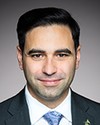Thank you, Mr. Chair and members of the committee. We appreciate the opportunity to be here today to discuss the Auditor General's fall 2016 report on operating and maintenance support for military equipment.
On behalf of all of us at this table and at National Defence, we'd like to acknowledge the work of Mr. Ferguson and his team, including Mr. Stock, in preparing the report. His recommendations will help us improve an area that is of critical importance to National Defence.
Indeed, there are few areas more important to us than operating and maintaining our equipment. There are fighter aircraft and unmanned aerial vehicles to frigates and submarines to modern tanks and weapons systems. There is also operational clothing and personal protective equipment.
The Canadian Armed Forces need it at their disposal and ready for deployment at a moment's notice if they are to fulfil their mission to protect Canada, defend North America, and contribute to international operations. They need equipment they can depend on so that when the unpredictable happens, they can respond, just as they did when a typhoon devastated the Philippines in 2013, killing more than 6,300 people.
Within days, Canadian Armed Forces personnel were on the ground delivering more than 230,000 pounds of food, and more than 10,000 pounds of shelter and building materials. The operation took a CC-144 Challenger, a CC-150 Polaris, three Globemasters, and three Griffon helicopters; and that's just in air support.
It is hard to predict what equipment our military will need next, so we err on the side of caution. We must ensure that our readiness levels are high, our stocks of spare parts are sufficient, and our women and men in uniform have access to the equipment they need, when they need it. We must also balance the needs of the forces, and flexibility, with the need to ensure value for money and economic benefits for Canadians.
The Auditor General acknowledged this in his report, noting that, “There is inherent complexity and unpredictability in forecasting equipment support that cannot be eliminated. National Defence must plan above minimum needs, so that its equipment is ready to respond to changing circumstances.” He concluded, however, that we can do better, and we certainly agree.
We welcome the Auditor General's recommendations on how we can move forward. We're committed to implementing all eight recommendations. Our plans to do that are in the management action plan that we tabled with the committee last week. We'd be pleased to answer your questions specific to any of the eight recommendations.
I'd like to spend just a couple of minutes, Mr. Chair, on three of the main themes that run through his report. The first pertains to planning assumptions and our need to make them stronger. On this front we're making some progress.
In 2016 we started rolling out a new sustainment initiative that replaced the previous policy for sustainment contracts. We now bring together procurement experts from National Defence, from Public Services and Procurement, and from Innovation, Science and Economic Development. These experts work in close co-operation with industry to identify the best approaches for in-service support for our equipment. The benefits of this collaboration are many, not the least of which is that we can obtain the information necessary to determine, by fleet, what kind of life-cycle maintenance is required, what industry can offer at what cost, and how the federal departments can leverage their collective resources and know-how to make it happen.
Through the sustainment initiative, we are able to work with industry partners from the outset to ensure that the contracts we sign give us flexibility to change our requirements. As a result, going forward an increasing number of our contracts include provisions to enable us to adjust to changing circumstances, which is our reality—provisions that will make the armed forces more agile and responsive and deliver greater value for money.
To ensure that contracts are in the best interests of the forces and taxpayers, all of our larger in-service support contracts are now subject to a rigorous sustainment business case analysis. This includes a thorough review of possible options, to ensure that the solution chosen balances equipment performance, flexibility, value for money, and economic benefits. The sustainment initiative is still in early days, but it is producing some promising results.
As part of a pilot that was under way while the Auditor General prepared his report, we negotiated new long-term contracts for the engines of the CF-18 Hornet, the CP-140 Aurora, and the legacy Hercules aircraft fleets.
Another recent example cited in the report relates to the Hercules aircraft. We did award the original contract to support that aircraft's maximum projected use in Afghanistan. At the end of that operation, a number of factors had resulted in the fleet spending less time in the air than planned. Consequently, our sustainment requirements also changed. We've since renegotiated the contract to better reflect our revised needs. In doing so, we've introduced more flexible pricing based on fleet usage. More to the point, we guarantee greater fleet availability at lower cost. We're confident that our new approach under this sustainment initiative will start to address some of the main concerns raised in the Auditor General's fall report.
A second theme in the report relates to costing. Doing complete life-cycle costing for military equipment is challenging. While some costs, such as the purchase price of a piece of equipment, are relatively easy to track, others, such as development and disposal costs and the operating and maintenance costs for a 20- to 30-year period, are more difficult. For instance, the life-cycle cost requires that we project the salaries of people who operate the equipment and those who support the equipment, be they military or civilian or our industry partners. We must also account for the amount of fuel required to operate a fleet and its cost in any given year. Tracking some of these costs, such as an operator's time, and tying them to a specific piece of equipment will be challenging. Trying to estimate these costs is difficult, but we are making improvements since consolidating a number of our information systems into a central one, the defence resource management information system, DRMIS.
Over the last 18 months we've made improvements in our costing. Cost estimates for all planned and ongoing acquisitions have been reassessed and validated, as part of our defence policy review, including incremental maintenance costs over the life of the equipment. We also now have a much more robust costing model. We have projected costs on a life-cycle basis for projects, such as the future fighter capability project, our fixed-wing search and rescue aircraft, and our Arctic offshore patrol ships. We're also working on a full life-cycle costing of the Canadian surface combatants, the new ships for the navy. We've increased the number of costing specialists in defence from 30 to 80, the largest in the federal government. We've instituted a rigorous program to train them. These internationally certified costers have the expertise to ensure that the information is available to support the development of our departmental investment plan.
Finally, the third theme of the Auditor General's report is performance measurement. We're in the early stages of developing a departmental results framework. Among other things, the framework will have to establish standardized rules for entering our performance data, and validating and reviewing information systems. This means we'll be able to better access data on how we manage our in-service support, and with better data comes a better understanding of results. By this time next year, the framework will enable us to begin establishing benchmarks against which we compare our performance. It will tell us whether we're meeting our expectations with respect to equipment availability and condition, and it will highlight where we can improve. Developing performance measures and indicators now will enable us to do much more than just report on performance. It will allow us to turn data into information, and information into business intelligence.
As we discussed with you in January, we've also been working on amalgamating several data sources into our resource management information system, and we use that system to greater effect in several areas. Building on our work to date, we'll use DRMIS and other analytics tools to implement the management action plan for this audit. For example, we'll use DRMIS to track fleet availability in a way that is more conducive to measuring the effectiveness of our in-service support contracts, and that will enable us to refresh and measure through-life cost information.
More than 20,000 defence members use the system across Canada, on ships at sea and in locations around the world. We want to expand its reach ever further. Vice-Admiral Lloyd can talk to you about the navy, which is the most advanced in this area. We hope to roll this work out into other platforms in the air force and army, which is the direction we're headed.
I recognize that the challenge before us is sizable. We are making progressing in addressing it, but we acknowledge that we have much more to do. Again, I'd like to thank the Auditor General for helping us. We agree with his assessment and are at work implementing his recommendations.
Thank you. My colleagues and I will be happy to take your questions.










